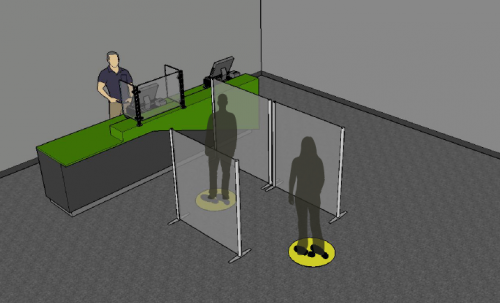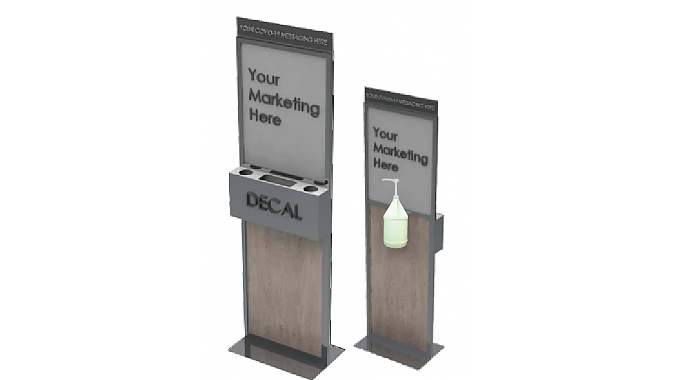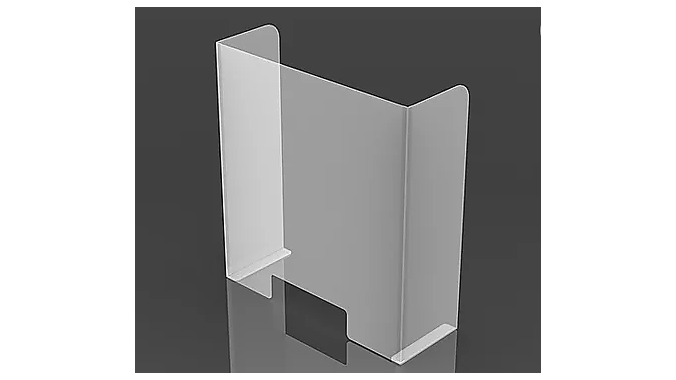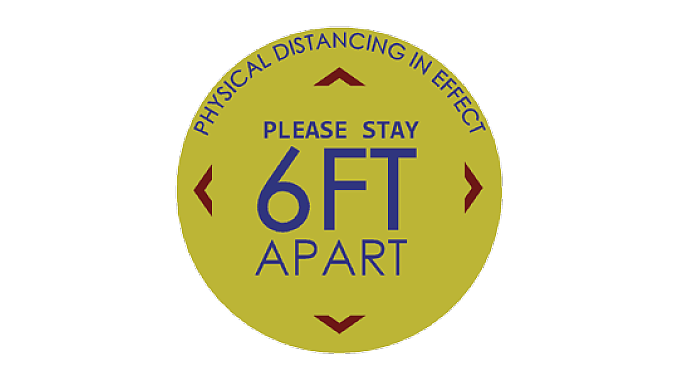By Holly Wiese
Editor's note: Holly Wiese is the owner of 3 Dots Design, a retail consulting agency focusing on store design, floorplan analysis, color consulting, visual merchandising and POP design.
What adjustments do you have to make to your shop in the face of COVID-19? What types of safety precautions and procedural changes are necessary to not only ensure the safety of your staff and customers, but to make customers FEEL safe enough to leave their homes and decide to enter your store again?
After sitting in on several retail webinars outside of our specialty channel, it has become abundantly clear that the task of creating a physical and emotional level of comfort for your customers is going to present even more challenges than adhering to the actual safety guidelines that will be required.
Why? Because that piece is intangible. It's difficult to know exactly HOW MUCH is enough to quell the anxiety of a nervous customer, but in our opinion, no reasonable amount of effort to ensure their comfort is too much.
I'm sure you're all familiar with the important safety signs, sanitizer displays, floor stickers and sneeze guards that have been circling around on email strings as "retail must-haves" to get open and stay open.
And of course these guidelines vary widely across the country and are changing quickly. So before you implement ANY safety actions and procedures, make sure you know the guidelines where you live.
OK, what about the merchandising of your space? Are there additional things you can do within your store walls that will help ensure further safety for your customers and help to regain their trust?
Store layout
Before people even enter the store, you want to reassure them as much as possible. Communicate through signage what you're doing to protect them and you. Reduce their anxiety. If you have hand sanitizer, wipes, gloves and masks to offer, great. And make it super-clear that you're doing so.
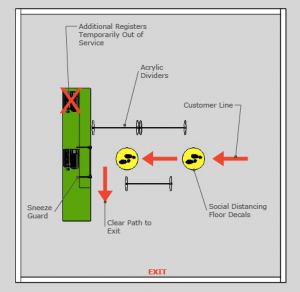
Now take a close look at the positioning of your floor fixtures. Are they set up in a way that 1) allows your customers to SAFELY walk throughout your entire space without having to touch any product or fixtures at all? And 2) do they ever lead your customers to a potential dead end, or area where they may feel uncomfortably close to another shopper should they decide to follow a similar path?
In other words, ALL fixtures should allow for your customer to navigate them with ease AND have a "way out" in the opposite direction, should another customer approach.
Cash wrap: Do you have a VERY clear process for customers to approach the counter, handle the transaction quickly and with minimal contact and then have them exit WITHOUT getting in the way of other customers needing to pay?
I realize most stores will have restrictions on how many customers can be in the store at the same time, but even with fewer shoppers, you don't want them bumping in to each other, or even getting close to doing so.
Floor stickers with directional arrows are a good place to start, as well as freestanding acrylic dividers to separate check-out lanes if you've got multiple stations running at the same time.
We've seen shops dividing the traffic flow and check-out lines with painters tape and the like. It only costs a few dollars more to make a professional presentation that fits in with the overall look of your store. We can help you with this.
If you've only got one register operating right now, perhaps lining the approach to it with some dividers would be helpful, allowing for a clear exit for your customer near the counter so that they don't have to backtrack in to the next customer in line behind them.
The main thing is that you're stepping back and looking at all areas of your space. If you have any potential pinch points in your traffic flow, then re-arrange or better yet, remove a fixture or two from the floor right now to open things up.
In addition to assessing the process and traffic flow during check out, if you're having trouble sourcing the proper safety shields needed to get back to business, our retail fixture vendor has pivoted to producing some fantastic pieces that we're happy to steer you to if needed (photos attached). Simply email us at: Ryan@3dotsdesign.com for more details on how to get them sent to your shop quickly.
Shoe fitting: If you are still performing shoe-fitting, are the benches or chairs situated in a way so that even if somebody is sitting on each one of them at the same time, there is adequate space between everybody? Should you consider placing freestanding plexiglass dividers between any of the benches to further ensure social distancing?
Merchandising
From a product merchandising perspective, the categories of bike test rides, apparel and nutrition stand out to us as potentially higher risk for your customers to shop than others due to their "high touch" nature.
Bike test rides: If you've been open for more than a minute, you know the drill here. Bleach or alcohol sprays on all contact points before and after every test ride, right? You can also offer your customer gloves to wear if that makes them feel more secure.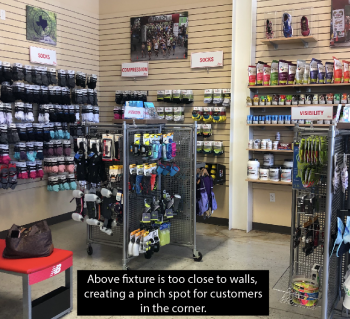
A couple other points on test rides: It's good to change your standard procedure on seat height adjustment and such. Holding the bars while you're facing the customer to check seat height? Not worth the discomfort or the fewer-than-six-feet distancing.
Here's where your experience and expertise come into play. Take your best guess at seat height (guess low!) and then watch the customer ride around a bit and adjust again if necessary.
Apparel: Multiple people pulling fitted clothing over their head (which means nose and mouth) potentially contaminating fabrics without knowing it along the way. Now, based on all of my research, a porous fabric is unlikely to hold on to these viruses for longer than 24-36 hours. However, within that period of time, it's still possible for several customers to touch or try on the same item. So how do we fix this?
• Not allowing trying on of apparel (sounds crazy but this whole situation is crazy). Create a simple sign: To help mitigate the risk of transferring the COVID-19 virus through our apparel, we have temporarily suspending any trying on in the store.
• If a customer wants to purchase an item, try it on at home and return later, you will know it has been touched and can be quarantined for several days in a "dirty" zone in your store where touched items take a time-out until possible virus droplets have left town.
• Feature four or five key outfits on mannequins at a time and pull ALL other apparel off the floor to be kept in the backroom. Create a sign: We have lots of sizes in the back, but to mitigate the spread of the COVID-19 virus through our apparel, our gloved and masked staff members will happily retrieve the size and style you are interested in purchasing.
• Your staff can safely go pull what is requested and same as in the first scenario, if a return happens later with this product, you can quarantine it properly before returning it to inventory.
• Less apparel on the floor in general is a good idea right now. Pull some amount off the floor (based on how crowded this area is), in order to create fewer points of human contact in this category.
• Try to make it so more apparel can be seen easily WITHOUT having to thumb through packed fixtures. Rotate some new pieces in weekly, but contain it to as few floor fixtures as possible. Less product, fewer fixtures, fewer points of contact are all good things right now, as it pertains to the safety of your customers.
Nutrition: It goes without saying that sampling is OUT for now. But beyond that, what about customers thumbing through the gels, bars or other small items that are often displayed in boxes or bins? Is it a concern to be increasing the number of points of contact between customers and these products? And if so, are there any other options to sell this category?
What about pulling backstock of nutrition out of the front area, similarly to what we suggested for apparel and have signs indicating that backstock can be easily pulled by safe staff members for those interested in larger nutrition purchases.
The thought is that much like a high-end bakery, when display-only products are in the cases, perhaps consider displaying singles of your top nutrition products only right now.
When people want several bars or gels, they can ask a staff member to go grab them and put them in a bag in the back to eliminate sorting through all the bins on the floor fixture. More work? Absolutely. Fewer points of human contact on a product to be consumed? Absolutely.
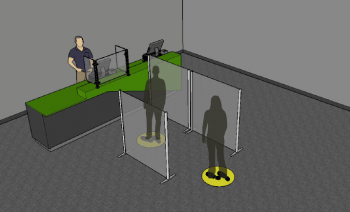
Perhaps for the next couple of months, all nutrition sales can be online only with a minimum purchase of "x" units in order to encourage stocking up on these products. That eliminates the temptation of sorting through edible products on the floor altogether.
Or, if you have a glass display case with some room, put nutrition behind glass for now. This will require a staff member to pull out what the customer is looking for and safely handling product only once.
Remember, all of these ideas are hopefully for the short term only and if your customers don't feel safe (or aren't safe), they're not coming back.
Losing some product on the floor right now or adding some steps to your staff service protocol are small prices to pay for gaining the trust and comfort level of your customers for the long term. They want to support you and all local businesses, but they have to feel safe in doing so.
Staff care
While we've focused on traffic flow and merchandising for the sake of your customers, make sure you're also taking care of yourself and your staff. We're hearing from shops across the country that owners and staff are exhausted, and we're a long way from past the pandemic.
This presents tough choices for owners and managers. While you want to make sure everyone who's working for you really wants to be there, it's crazy busy in most bike shops right now and you need your staff.
How about rotating paid days off? Rotating people's job duties so the customer interactions are shared? Doing business by appointment only, having the bike and needed accessories ready for the customer when they come in?
There are plenty of creative solutions here depending on so many different factors. The point is, don't spend so much time and energy on the customers' needs and neglect your staff's physical and emotional health.
We hope these tips have been helpful in giving you some guidance as you navigate the tricky process of re-opening safely. If you need assistance in finding any other retail safety pieces for the process such as social distancing floor stickers, acrylic divider panels or hand sanitizer/safety stations to greet customers at the front entry, feel free to reach out to us at 303-588-0565 or email us at ryan@3dotsdesign.com.

